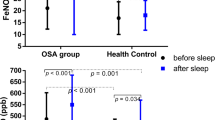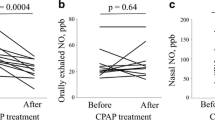Abstract
Background
The aim of the study was to evaluate exhaled nitric oxide (eNO) derived from different areas of airway in obstructive sleep apnea hypopnea syndrome (OSAHS) patients with NO exchange model and investigate the potential application and interpretation of eNO in clinical setting.
Methods
This study was divided into two parts. Firstly, we performed a case control study in 32 OSAHS patients and 27 non-OSAHS participants. Fractional eNO (FeNO) and eNO from the central airway (J’awNO) and from alveoli (CANO) were compared in OSAHS and control groups. Also, correlation of eNO to severity of OSAHS was analyzed. Secondly, a prospective study was conducted in 30 severe OSAHS patients who received a short-term nasal continuous positive airway pressure (nCPAP) treatment. We evaluated eNO, plasma ET-1 concentration, and echocardiography during the treatment process and explored the potential relationship among them.
Results
FeNO and J’awNO were higher in OSAHS and associated with disease severity, while CANO was relatively lower. After nCPAP treatment in severe OSAHS patients, FeNO and J’awNO decreased and CANO increased significantly. Substantial agreement was shown between the elevation of CANO and the decrease of plasma ET-1 concentration after nCPAP by Kappa analysis for consistency. Tei index, which is considered indicative of global right ventricular function, might be predicted by plasma ET-1 levels in severe OSAHS patients.
Conclusions
NO exchange model provides us with more information of eNO derived from different areas. eNO is not only confirmed to be an effective method for airway inflammation evaluation in the follow-up of OSAHS, CANO may also serve as a useful marker in monitoring endothelial function, resistance of pulmonary circulation, and right ventricular function for clinical implication.



Similar content being viewed by others
References
Yaggi HK, Strohl KP (2010) Adult obstructive sleep apnea/hypopnea syndrome: definitions, risk factors, and pathogenesis. Clin Chest Med 31:179–186
Ryan S, McNicholas WT (2008) Intermittent hypoxia and activation of inflammatory molecular pathways in OSAS. Arch Physiol Biochem 114:261–266
Selmi C, Montano N, Furlan R, Keen CL, Gershwin ME (2007) Inflammation and oxidative stress in obstructive sleep apnea syndrome. Exp Biol Med (Maywood) 232:1409–1413
Ryan S, Taylor CT, McNicholas WT (2009) Systemic inflammation: a key factor in the pathogenesis of cardiovascular complications in obstructive sleep apnoea syndrome? Postgrad Med J 85:693–698
Marin JM, Carrizo SJ, Vicente E, Agusti AG (2005) Long-term cardiovascular outcomes in men with obstructive sleep apnoea-hypopnoea with or without treatment with continuous positive airway pressure: an observational study. Lancet 365:1046–1053
Giles TL, Lasserson TJ, Smith BH, White J, Wright J, Cates CJ (2006) Continuous positive airways pressure for obstructive sleep apnoea in adults. Cochrane Database Syst Rev CD001106
From the Global Strategy for Asthma Management and Prevention, Global Initiative for Asthma (GINA) 2014. Available from: http://www.ginasthma.org/. Accessed on 2014 Dec 30
George SC, Hogman M, Permutt S, Silkoff PE (2004) Modeling pulmonary nitric oxide exchange. J Appl Physiol (1985) 96:831–839
Tsoukias NM, George SC (1998) A two-compartment model of pulmonary nitric oxide exchange dynamics. J Appl Physiol (1985) 85:653–666
Morris SJ, Billiar TR (1994) New insights into the regulation of inducible nitric oxide synthesis. Am J Physiol 266:E829–E839
Fortuna AM, Miralda R, Calaf N, Gonzalez M, Casan P, Mayos M (2011) Airway and alveolar nitric oxide measurements in obstructive sleep apnea syndrome. Respir Med 105:630–636
Foresi A, Leone C, Olivieri D, Cremona G (2007) Alveolar-derived exhaled nitric oxide is reduced in obstructive sleep apnea syndrome. Chest 132:860–867
American Thoracic Society, European Respiratory Society (2005) ATS/ERS recommendations for standardized procedures for the online and offline measurement of exhaled lower respiratory nitric oxide and nasal nitric oxide. Am J Respir Crit Care Med 171:912–930
Johns M (1998) Rethinking the assessment of sleepiness. Sleep Med Rev 2:3–15
Polysomnography Task Force, American Sleep Disorders Association Standards of Practice Committee (1997) Practice parameters for the indications for polysomnography and related procedures. Sleep 20:406–422
Ishizawa K, Yoshizumi M, Tsuchiya K, Houchi H, Minakuchi K, Izawa Y, Kanematsu Y, Kagami S, Hirose M, Tamaki T (2004) Dual effects of endothelin-1 (1-31): induction of mesangial cell migration and facilitation of monocyte recruitment through monocyte chemoattractant protein-1 production by mesangial cells. Hypertens Res 27:433–440
American Thoracic Society (1995) Standardization of spirometry, 1994 update. Am J Respir Crit Care Med 152:1107–1136
Tei C, Ling LH, Hodge DO, Bailey KR, Oh JK, Rodeheffer RJ, Tajik AJ, Seward JB (1995) New index of combined systolic and diastolic myocardial performance: a simple and reproducible measure of cardiac function—a study in normals and dilated cardiomyopathy. J Cardiol 26:357–366
Olopade CO, Christon JA, Zakkar M, Hua C, Swedler WI, Scheff PA, Rubinstein I (1997) Exhaled pentane and nitric oxide levels in patients with obstructive sleep apnea. Chest 111:1500–1504
Culla B, Guida G, Brussino L, Tribolo A, Cicolin A, Sciascia S, Badiu I, Mietta S, Bucca C (2010) Increased oral nitric oxide in obstructive sleep apnoea. Respir Med 104:316–320
Salerno FG, Carpagnano E, Guido P, Bonsignore MR, Roberti A, Aliani M, Vignola AM, Spanevello A (2004) Airway inflammation in patients affected by obstructive sleep apnea syndrome. Respir Med 98:25–28
Boyd JH, Petrof BJ, Hamid Q, Fraser R, Kimoff RJ (2004) Upper airway muscle inflammation and denervation changes in obstructive sleep apnea. Am J Respir Crit Care Med 170:541–546
Inancli HM, Enoz M (2010) Obstructive sleep apnea syndrome and upper airway inflammation. Recent Patents Inflamm Allergy Drug Discov 4:54–57
Carpagnano GE, Spanevello A, Sabato R, Depalo A, Turchiarelli V, Foschino BM (2008) Exhaled pH, exhaled nitric oxide, and induced sputum cellularity in obese patients with obstructive sleep apnea syndrome. Transl Res 151:45–50
Depalo A, Carpagnano GE, Spanevello A, Sabato R, Cagnazzo MG, Gramiccioni C, Foschino-Barbaro MP (2008) Exhaled NO and iNOS expression in sputum cells of healthy, obese and OSA subjects. J Intern Med 263:70–78
Yamauchi M, Nakano H, Maekawa J, Okamoto Y, Ohnishi Y, Suzuki T, Kimura H (2005) Oxidative stress in obstructive sleep apnea. Chest 127:1674–1679
Tanaka T, Nakamura H, Yodoi J, Bloom ET (2005) Redox regulation of the signaling pathways leading to eNOS phosphorylation. Free Radic Biol Med 38:1231–1242
Lui MM, Lam DC, Ip MS (2013) Significance of endothelial dysfunction in sleep-related breathing disorder. Respirology 18:39–46
Feng J, Zhang D, Chen B (2012) Endothelial mechanisms of endothelial dysfunction in patients with obstructive sleep apnea. Sleep Breath 16:283–294
Kohler M, Stradling JR (2010) Mechanisms of vascular damage in obstructive sleep apnea. Nat Rev Cardiol 7:677–685
Conflict of interest
The authors declare that they have no competing interests.
Funding
This research was supported by the Shanghai Leading Academic Discipline Project (B115), National Natural Science Foundation of China (81400043, 81100048, 81300055), Key Medical Grant from Shanghai Science and Technology Committee (13430720500), and Grant from Ministry of Education of China (20130071110044).
Author information
Authors and Affiliations
Corresponding author
Additional information
Yuanlin Song, Shanqun Li and Chunxue Bai contributed equally to this work.
Rights and permissions
About this article
Cite this article
Liu, J., Li, Z., Liu, Z. et al. Exhaled nitric oxide from the central airway and alveoli in OSAHS patients: the potential correlations and clinical implications. Sleep Breath 20, 145–154 (2016). https://doi.org/10.1007/s11325-015-1198-7
Received:
Revised:
Accepted:
Published:
Issue Date:
DOI: https://doi.org/10.1007/s11325-015-1198-7




